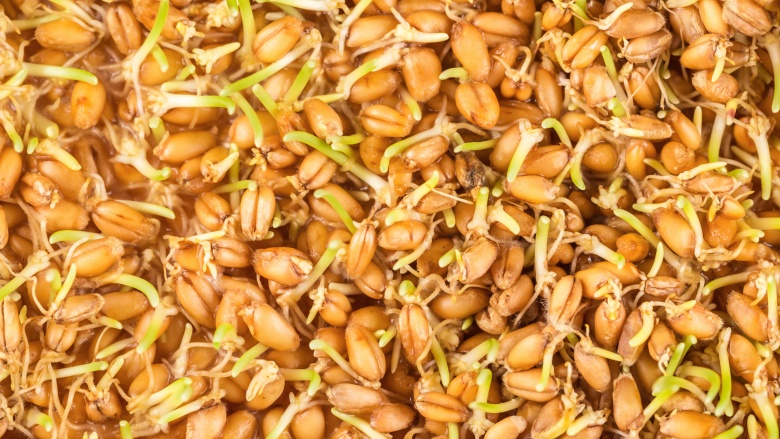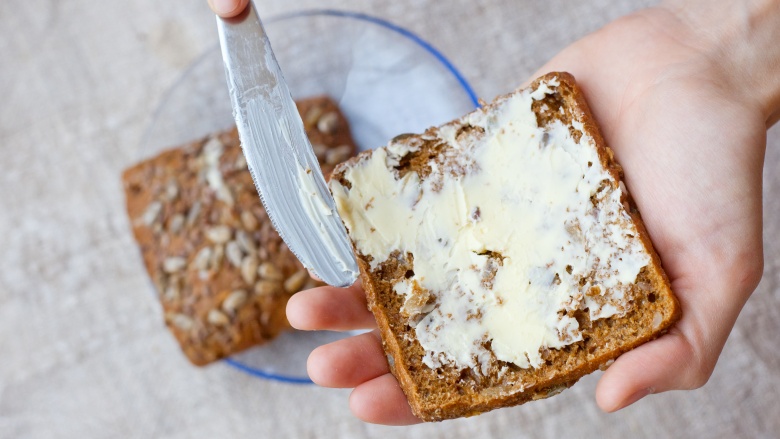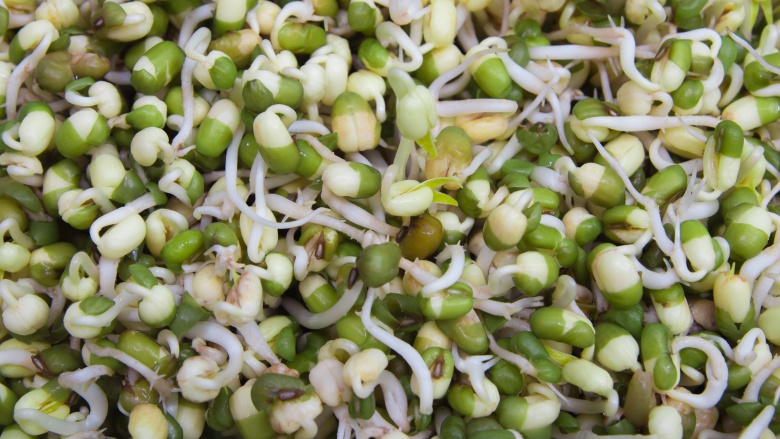Everything You Ever Wanted To Know About Sprouted Bread
You've seen it at the grocery store, read about it on nutrition blogs — maybe you've even been enjoying it toasted and slathered with your favorite hummus. Sprouted bread is seemingly everywhere, and along with it, a host of nutrition claims that seek to elevate it to the top of the superfood list. Beloved by whole-food gurus, sprouted bread sure seems like much more than a fad ... but what's it all about? How is it made? Is it really that good for you? Read on to find out.
The history of sprouted bread
Humans have been relying on grains like wheat for sustenance for thousands of years, with consumption of bread dating back to 8,000 BC. The bread eaten by our ancestors, however, was very different from the bread we purchase today at the supermarket. Traditionally, ancient wheat and other grains, once gathered, were stored in damp conditions which caused the seeds to germinate, or sprout. The sprouted grains were then ground into unleavened flatbreads and cooked over a fire, creating an ideal portable food for a hungry tribe.
The sprouted bread you can buy at the store today, meanwhile, is made with grains and/or legumes that have been permitted to reach the same sprouting stage. The sprouted grains are then ground into a meal and incorporated into a bread recipe that includes no processed flours, imparting a nutty flavor and chewy texture. According to the New Yorker, many believe conventional breads are not the way to go, since they're are made with certain grains that our modern-day bodies simply cannot digest. The process of sprouting grains, however, transforms the nutritional content of the grain, making them much easier for the body to handle.
Nutrition and sprouted bread
It's no secret that white bread gives us very little in the way of nutrition. Devoid of much of its fiber and vitamin content, white flour has been implicated more than once in the obesity and diabetes epidemics. It may surprise you to learn, however, that the whole wheat bread you've been told is the healthier choice doesn't fare too well on the glycemic index either, with one serving raising blood sugar as much as a candy bar, according to a study by Harvard Medical School.
The nutrition claims of sprouted bread, however, are far-reaching. Processed, refined wheat, like most of what is commercially available today, has been stripped of its germ and bran. This process, while delivering the grain a longer lifespan, also removes precious nutrients. Sprouted grains, on the other hand, undergo a nutritional metamorphosis, not only preserving but actually increasing vitamins, minerals and natural enzymes (according to the Weston A. Price Foundation,) while also encouraging the growth of digestion-friendly probiotics. The sprouting process also reduces the amount of phytate, lectins, and enzyme inhibitors found naturally in all grains. Bread made with sprouted grains, therefore, is nutrient-dense, with a lower glycemic load than modern day bread.
Additionally, as told by The Science Of Eating, sprouted grain bread boasts higher protein, lower carbohydrates, and increased fiber, making it an excellent choice for diabetics, those with inflammatory conditions, and anyone looking to watch their waistline. It is important to note what Health Now Medical said, however, that while sprouted bread may contain less gluten than its processed counterpart, it is not all gluten-free — unless labeled as such — and should not be consumed by anyone living with Coeliac disease or a wheat allergy.
How to make sprouted grain bread
Sprouted grain breads are readily available in grocery stores (check the freezer aisle!) or for purchase online. If you want to try your hand at making it at home, you will need to soak, germinate, and dry your own wheat berries or other grains or legumes, and grind them to flour using a food processor (true sprouted grain breads contain no commercially processed flour.) Use your freshly-made sprouted grain flour to make a recipe of your choosing (or try this delicious recipe from Bread Experience). Take care to bake the bread at a low temperature, in order to preserve the sprouted bread's valuable enzymes. Store your sprouted grain bread in the freezer or refrigerator, as it spoils quickly at room temperature.
Best ways to use sprouted bread
Sprouted bread can be used in the same manner you'd use any of your favorite bread in a savory recipe. Try it as a nutty and healthful alternative the next time you're making your favorite sandwich. Throw a couple slices into your food processor and grind down into bread crumbs to use in meatballs, a veggie loaf, or as a breading for a baked or pan-fried meat or vegetable. It should be noted, however, that according to Mark Mathew Braunstein, author of Sprout Garden: Indoor Grower's Guide to Gourmet Sprouts, heating sprouted bread to a temperature above 115 degrees Fahrenheit is believed to destroy many of the beneficial enzymes which make sprouted bread so special, though it will still contain a higher protein content and lower carbohydrates than traditional breads.




